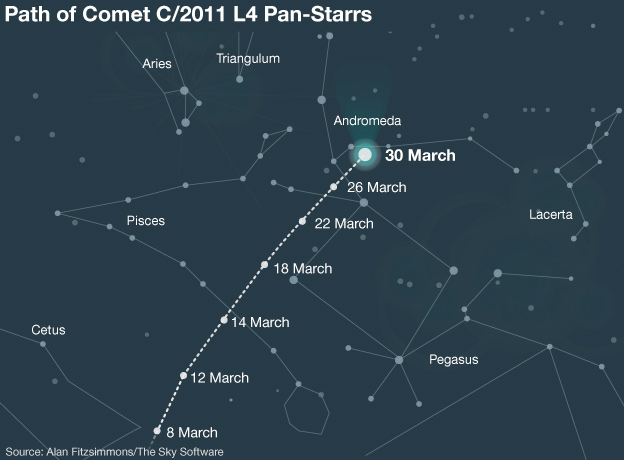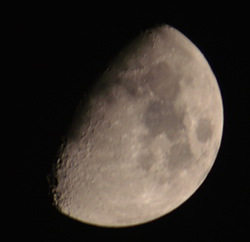Posts Tagged ‘moon’
C/2011 L4 Pan-Starrs Comet
The second Comet this year will be lighting up our skies over the next few nights. This one, named C/2011 L4 Pan-Starrs, was visible using binoculars or a telescope from the 8th March and will become brightest on the 10th March with the best days to view it being on the 12th and 13th as it is in a great place in the Sky to be able to pick it out. At this point, provided it is a clear sky, you should be able to see it with the naked eye.
It should be pretty straightforward to spot as it is close to the crescent Moon in a western direction. To find the Comet, find the Moon just after sunset, and look down and slightly to the left of it. With binoculars you should see the head of the comet very clearly and even the two types of tails coming from it. As the month rolls on, the Comet will appear higher and higher in the sky and later in the evening until it disappears when we reach the month of April.
Comet C/2011 L4 Pan-Starrs was first discovered in June 2011 and is believed to originate from the Oort Cloud. It was picked up in Hawaii by the Pan-Starrs telescope, which is why they have given the Comet its name. Scientists believe that this could be the first time it has appeared in our system as they believe it is a non-periodic Comet, and it may not return for another 100,000 years. So it is definitely a once in a lifetime Comet!!
The Comet itself is thought to have a nucleus of about 20-30KM in diameter but due to the dust and material surrounding it, it could well span more than a million kilometres which is insane to think about in my opinion!
Professor Mark Bailey, director of the Armagh Observatory in Northern Ireland, has said this about the new Comet, “We have great hopes for this comet. Of course we are always very cautious – even now we don’t know how bright it is going to get – but we are keeping out fingers crossed.”
He also said, “After sunset, scan the horizon roughly in the western direction. On the 12 and 13 March, there is a nice association with the thin crescent Moon. You can use the Moon as a guide, and search just down or to the left of the Moon. Through binoculars you should be able to see the head of the comet and certainly the two types of the tail. I would always advise people to hunt for comets with binoculars, but if you have found it with binoculars, have a good hunt around and see if you can see it with the naked eye. That’s quite a challenge – but it is a wonderful thing to have seen.”
Below is an image of the path of the Comet in our night sky in March, so enjoy Comet hunting over the next couple of days and weeks.
Let me know if you see it by either leaving a comment here or tweeting me at @strethewey #nightskyastronomy.
Asteroid 2012 DA14
On February 15th 2013, an Asteroid will be passing by Earth closer to us than the Moon is to our planet and closer to us than some satellites that we have orbiting us. There was a time when some scientists thought that the Asteroid would hit Earth, but they now believe it will miss us (thank goodness!), and will travel pass us at about 17,200 miles away. This is still pretty close and may possibly allow us, if it is a clear day and night, to view the Asteroid at some point. Those of us with access to good binoculars and telescopes should have a good view if the skies are clear.
To put the distance that Asteroid 2012 DA14 will swing by us in context, the Moon is 240,000 miles away and geosynchronous satellites are about 26,000 miles away. So the Asteroid will travel approx 9,000 miles closer to us than these satellites. The Asteroid itself is a small one compared to most others and is about 45m across with a mass of about 130,000 metric tons, but would still have caused some damage if it actually hit us!
NASA have released a statement regarding the Asteroid with a few more tidbits of information,
‘On [February 15, 2013], the asteroid will travel rapidly from the southern evening sky into the northern morning sky with its closest Earth approach occurring about 19:26 UTC when it will achieve a magnitude of less than seven, which is somewhat fainter than naked eye visibility. About 4 minutes after its Earth close approach, there is a good chance it will pass into the Earth’s shadow for about 18 minutes or so before reappearing from the eclipse. When traveling rapidly into the northern morning sky, 2012 DA14 will quickly fade in brightness.‘
Blue Moon
On August 31st, we will see the next Blue Moon.
Unfortunately, it doesn’t mean that the moon will be the colour blue, although that would be cool, but it means that there will be two full moons in a single month. The first full moon of the month occurred on the 1st August so there is enough time left in the month for the next full moon to come around. This can happen every 2-3 years, so isn’t actually out of the ordinary. It is also possible for there to be double Blue Moons in a single year which last happened in 1999 when there were two full moons in January and March but no full moon in February. The next time this will happen will be 2018.
There are actually two definitions of a blue moon. The first is what I have written above which originated in the 1940’s, but the other is when there are 4 full moons in a single season (Winter, Spring, Summer or Autumn). The third full moon out of the four is then called the Blue Moon. This came about centuries ago in folklore through old Farmers’ stories. The next one of these Blue Moons will be on August 21st 2013.
But whichever definition you prefer, either way, it is a special month for our companion, the Moon!
Lyrid Meteor Shower
This year the annual Lyrid Meteor Shower should be a great spectacle as the Moon will not be lighting up the sky at all. As long as you are out in the country and have the luck of a clear sky, there should be a perfect view of the meteors. Even in a lighter sky, it should be a good sight.
The height of the shower falls on the night of the 21st April with the average number of meteors spotted per hour being at about 10-20, but it has been known to reach up to 100 meteors per hour! On the nights around the peak night, you should still be able to see the occasional meteor. I had a look last night but unfortunately didn’t see any, mainly because the area of the sky where they seem to originate from (The constellation Lyra near the bright star called ‘Vega’.) was too low on the horizon and was hidden by trees.
The Lyrids are thought to be sand grain sized debris from a passing comet. When they hit the Earth’s atmosphere, they burn up, causing the light streaks in the Sky. In the past, fireballs have been seen hurtling across the sky during this meteor shower. They are thought to originate from comet Thatcher that has an orbit of 416 years with its path staying practically the same each time is passes through. This means the debris is always in the path of the Earth which is why it is an annual event.
So fingers crossed everyone gets to see a good few meteors! 😉

